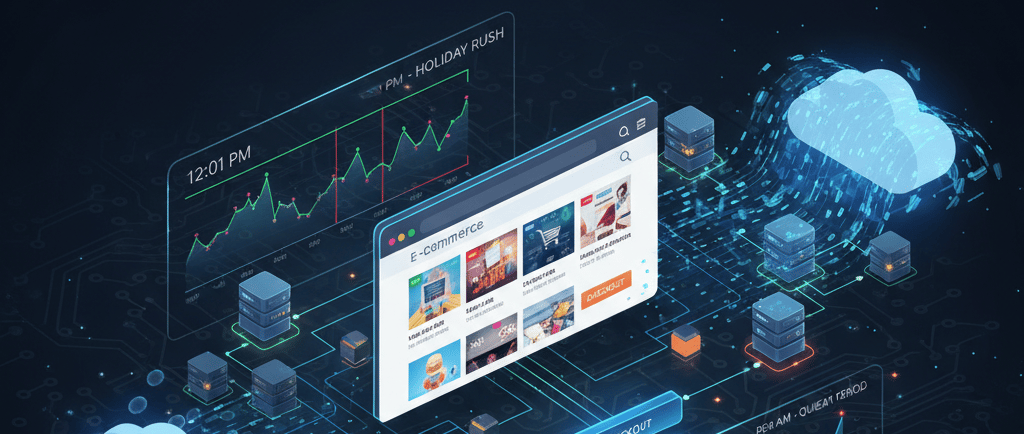Riding the Wave: How Dynamic Scaling Delivers E-commerce Success (and Major Savings)
Bryon Spahn
9/26/20253 min read


For e-commerce businesses and any application facing predictable or unpredictable seasonal spikes, the struggle is real. The holiday rush, flash sales, back-to-school season – these are moments of immense opportunity, but also immense pressure on your infrastructure. The traditional approach? Over-provisioning. Buy enough servers to handle your absolute peak, even if they sit idle 90% of the time. This might guarantee uptime, but it’s a direct hit to your bottom line.
There’s a better way. At Axial ARC, we specialize in helping technology professionals build and convert applications to leverage dynamically scalable capacity. This isn't just about avoiding crashes; it's about optimizing performance, enhancing user experience, and unlocking significant cost savings.
The Problem with Static Provisioning
Imagine a highway designed for rush hour, 24/7. That's essentially what static provisioning is for your application. You pay for lanes that are empty most of the day, just to ensure smooth traffic during peak times.
Wasted Resources: Unused servers consume power, take up physical space (if on-premise), and represent a capital expenditure that isn't generating value.
Maintenance Overhead: Even idle servers require patching, monitoring, and general upkeep.
Slow Innovation: Resources tied up in over-provisioned infrastructure can’t be reinvested in new features or development.
Risk of Under-provisioning: The flip side is even worse. Underestimate demand, and your application grinds to a halt, leading to lost sales, frustrated customers, and reputational damage.
The Power of Dynamic Scaling
Dynamic scaling, at its core, means your infrastructure adapts to demand in real-time. When traffic surges, your capacity automatically expands. When the rush subsides, it seamlessly shrinks back down. This is typically achieved through cloud-native services like AWS Auto Scaling, Azure Autoscale, or Google Cloud Autoscaling, often orchestrated with containerization technologies like Kubernetes.
Here's a simplified look at how it works:
Monitoring: Your application's key metrics (CPU utilization, network I/O, request queue length, memory usage) are constantly monitored.
Thresholds: You define thresholds. For example, if CPU utilization consistently exceeds 70% for five minutes, it's time to scale up.
Action: When a threshold is met, new instances (virtual machines, containers, or even serverless functions) are automatically provisioned and brought online.
Load Balancing: A load balancer distributes incoming traffic across all available instances.
Scaling Down: When demand decreases and metrics fall below a "scale-down" threshold, instances are gracefully terminated, returning resources to the pool.
Imagine your application as a living entity, breathing in and out with the rhythm of your customer demand.
The Value Proposition for Technology Professionals
Moving to dynamically scalable capacity isn't just a technical upgrade; it's a strategic business decision.
1. Unmatched Cost Savings
This is where dynamic scaling truly shines. Instead of paying for peak capacity 24/7, you only pay for what you use, when you use it.
Reduced Infrastructure Costs: Cloud providers typically charge by the hour or even by the second for compute resources. Scaling down means your monthly bill reflects actual usage, not theoretical maximums. For seasonal businesses, this can mean massive savings during off-peak periods.
Lower Operational Overheads: Less static infrastructure means less to maintain, patch, and monitor manually. Your team can focus on innovation rather than infrastructure babysitting.
Elimination of Capital Expenditure (CapEx): For on-premise solutions, dynamically scalable capacity in the cloud shifts costs from CapEx to OpEx, freeing up capital for other investments.
2. Enhanced Performance and Reliability
Consistent User Experience: No more slow loading times or frustrating timeouts during peak demand. Your application maintains optimal performance, leading to higher customer satisfaction and conversion rates.
Proactive Resilience: Dynamic scaling can be configured to respond to unexpected spikes, providing a layer of resilience against sudden traffic surges or even DDoS attacks (when combined with other security measures).
Disaster Recovery (DR) and High Availability (HA) Integration: Cloud-native scaling often goes hand-in-hand with robust DR and HA strategies, ensuring your application remains available even in the face of regional outages.
3. Agility and Innovation
Faster Time to Market: Developers can deploy new features and applications without waiting for lengthy infrastructure provisioning cycles.
Experimentation: The ability to spin up and tear down environments quickly makes it easier to test new ideas, A/B test features, and iterate rapidly.
Focus on Core Business: By offloading infrastructure management to automated systems and cloud providers, your engineering team can concentrate on building core business value.
Partnering with Axial ARC
At Axial ARC, we understand the complexities of migrating existing applications or designing new ones to fully leverage dynamically scalable capacity. We partner with technology professionals like you to:
Assess your current infrastructure and application architecture: Identify bottlenecks and opportunities for optimization.
Design a tailored dynamic scaling strategy: Based on your specific application needs, traffic patterns, and business goals.
Implement cloud-native solutions: Utilizing leading platforms like AWS, Azure, and Google Cloud, along with containerization and orchestration tools.
Provide ongoing support and optimization: Ensuring your dynamically scalable environment continues to perform optimally and cost-effectively.
Don't let static infrastructure hold your e-commerce business back. Embrace the future of application scaling and unlock the full potential of your operations. Contact Axial ARC today to explore how dynamic scaling can transform your application and drive significant value for your organization.
